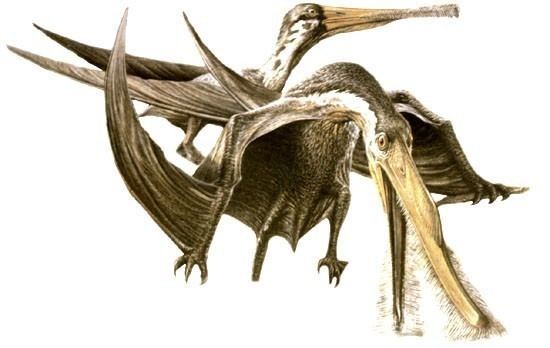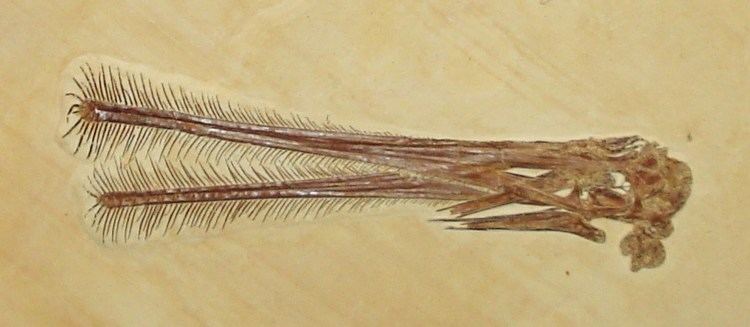Subfamily †Ctenochasmatinae Rank Genus | Class Reptilia Family †Ctenochasmatidae Phylum Chordata Order Pterosaurs | |
 | ||
Similar Pterosaurs, Gnathosaurus, Germanodactylus, Ctenochasmatidae, Ctenochasmatoidea | ||
Ctenochasma (meaning 'comb jaw') is a genus of Late Jurassic pterosaur belonging to the suborder Pterodactyloidea. Three species are currently recognized: C. roemeri (named after Friedrich Adolph Roemer), C. taqueti, and C. elegans. Their fossilized remains have been found in the Solnhofen Limestone of Bavaria, Germany, the "Purbeck Group" of northeastern Germany, and the Calcaires tâchetés of eastern France.
Contents

Description

Ctenochasma is distinguished mainly by its numerous (over 400 in adults) long, thin, curved and closely packed teeth, which lined its elongated and narrow snout. The teeth were so closely packed that they formed a comb, and in adults they projected outward away from the jaws, forming a basket; traditionally, these are thought to indicate a filter feeding lifestyle, straining water through the teeth in order to capture and eat small invertebrates, but unlike the related Pterodaustro it lacks adaptations that would form a pumping mechanism. Instead, the spetulate profile formed by the teeth probably indicate a spoonbill-like lifestyle, increasing the surface area of the jaws in order to catch small prey. The snout curved slightly upward and was rounded at the tip, and the teeth were restricted to the front half of the jaws.

The smallest species, Ctenochasma elegans, had a wingspan of only about 25 cm. Ctenochasma is distinguished by its mouth which contained as many as 260 long, thin comb-like teeth. Adult Ctenochasma had a bony crest along the skull, though this is not found in juveniles.

Comparisons between the scleral rings of both Ctenochasma elegans and Ctenochasma taqueti and modern birds and reptiles suggest that these taxa may have been nocturnal, and may have had activity patterns similar to modern nocturnal seabirds. This may also indicate niche partitioning with contemporary pterosaurs inferred to be diurnal, such as Pterodactylus and Scaphognathus.

Compared to other ctenochasmatoids, it had larger wings, and may have displayed a flying style comparable to that of modern skuas.
Species

The name Ctenochasma was coined by the German paleontologist Christian Erich Hermann von Meyer in 1852, based on a single lower jaw full of closely packed teeth which he gave the species name Ctenochasma roemeri. A second species, C. gracile, was named by Oppel in 1862 based on a fragmentary skull. However, a year earlier, another, more complete specimen probably belonging to the same species was described and named Pterodactylus elegans by Wagner. Because the species name elegans was named before gracile, the species is now known as Ctenochasma elegans. Another specimen originally attributed to a small or juvenile Pterodactylus, P. brevirostris (the second pterosaur to be named, which was later placed in its own genus Ptenodracon), probably represents a young juvenile Ctenochasma. An additional species, C. porocristata, was named by Paul de Buisonjé in 1981. However, it was differentiated mainly by the presence of a crest along the snout, which has since been shown to be a feature related to growth or sex, rather than species.
A fourth species of Ctenochasma was first described (but not named) by Philippe Taquet in 1972. A single specimen, consisting of a partial skull with complete brain case, was found in France and housed in the collections of the Saint-Dizier Museum. Detailed comparison to other Ctenochasma specimens in 2004 confirmed that it was a new species. In honor of Taquet's work on the specimen, Christopher Bennett named the species C. taqueti in 2007.
Classification
Cladogram following Andres, Clark & Xu, 2014.
